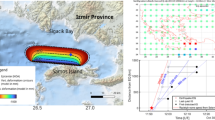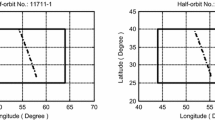Abstract
Over the last century, abnormal electromagnetic (EM) emissions associated with earthquake (EQ) activities have been widely reported and recorded by ground-based and satellite observations. The mechanism of extremely low-frequency (ELF) EM waves radiating from earthquakes has been gradually established. However, whether EM waves radiated from earthquakes can be detected by low Earth orbit (LEO) satellites remains controversial. In this paper, to address these concerns, a lithosphere-atmosphere-ionosphere model of ELF wave propagation is constructed. The features of the simulated EM field at LEO satellite altitudes radiated from earthquakes have been studied. The simulated EM field at the altitude of the China Seismo-Electromagnetic Satellite (CSES) is compared with the sensitivity of electromagnetic (EM) sensors onboard the CSES. The results illustrate that an earthquake with a magnitude over 6.0 can be detected by the EM sensors of the CSES. However, this depends on the focal depth, seismogenic environment and ionospheric parameters.
Similar content being viewed by others
References
Freund F. Pre-earthquake signals: Underlying physical processes. J Asian Earth Sci, 2011, 41: 383–400
Gokhberg M B, Morgounov V A, Yoshino T, et al. Experimental measurement of electromagnetic emissions possibly related to earthquakes in Japan. J Geophys Res, 1982, 87: 7824–7828
Hayakawa M. VLF/LF radio sounding of ionospheric perturbations associated with earthquakes. Sensors, 2007, 7: 1141–1158
Huang Q. Rethinking earthquake-related DC-ULF electromagnetic phenomena: Towards a physics-based approach. Nat Hazards Earth Syst Sci, 2011, 11: 2941–2949
Sorokin V M, Chmyrev V M, Yaschenko A K. Electrodynamic model of the lower atmosphere and the ionosphere coupling. J Atmos Sol-Terrestrial Phys, 2001, 63: 1681–1691
Nitsan U. Electromagnetic emission accompanying fracture of quartz-bearing rocks. Geophys Res Lett, 1977, 4: 333–336
Huang Q. One possible generation mechanism of co-seismic electric signals. Proc Jpn Acad Ser B, 2002, 78: 173–178
Ikeya M, Takaki S, Matsumoto H, et al. Pulsed charge model of fault behavior producing Seismic Electric Signals (SES). J Circuit Syst Comp, 1997, 07: 153–164
Mizutani H, Ishido T, Yokokura T, et al. Electrokinetic phenomena associated with earthquakes. Geophys Res Lett, 1976, 3: 365–368
Johnston M J S. Review of electric and magnetic fields accompanying seismic and volcanic activity. Surveys Geophys, 1997, 18: 441–476
Yoshida S, Uyeshima M, Nakatani M. Electric potential changes associated with slip failure of granite: Preseismic and coseismic signals. J Geophys Res, 1997, 102: 14883–14897
Sasaoka H, Yamanaka C, Ikeya M. Measurements of electric potential variation by piezoelectricity of granite. Geophys Res Lett, 1998, 25: 2225–2228
Gao Y X, Chen X, Hu H, et al. Induced electromagnetic field by seismic waves in Earth’s magnetic field. J Geophys Res Solid Earth, 2014, 119: 5651–5685
Gao Y X, Harris J M, Wen J, et al. Modeling of the coseismic electromagnetic fields observed during the 2004 Mw 6.0 Parkfield earthquake. Geophys Res Lett, 2016, 43: 620–627
Ren H, Huang Q, Chen X. Numerical simulation of seismo-electromagnetic fields associated with a fault in a porous medium. Geophys J Int, 2016, 206: 205–220
Tang J, Zhan Y, Wang L F, et al. Electromagnetic coseismic effect associated with aftershock of Wenchuan M(s)8.0 earthquake (in Chinese). Chin J Geophys, 2010, 53: 526–534
Du A, Huang Q, Yang S. Epicenter location by abnormal ULF electromagnetic emissions. Geophys Res Lett, 2002, 29: 94-1–94-3
Cohen M B, Inan U S. Terrestrial VLF transmitter injection into the magnetosphere. J Geophys Res, 2012, 117: A08310
Lehtinen N G, Inan U S. Full-wave modeling of transionospheric propagation of VLF waves. Geophys Res Lett, 2009, 36: L03104
Zhao S, Zhou C, Shen X, et al. Investigation of VLF transmitter signals in the ionosphere by ZH-1 observations and full-wave simulation. J Geophys Res Space Phys, 2019, 124: 4697–4709
Larkina V I, Migulin V V, Molchanov O A, et al. Some statistical results on very low frequency radiowave emissions in the upper ionosphere over earthquake zones. Phys Earth Planet Inter, 1989, 57: 100–109
Parrot M. Statistical study of ELF/VLF emissions recorded by a low-altitude satellite during seismic events. J Geophys Res, 1994, 99: 23339–23348
Serebriakova O N, Bilichenko S V, Chmyrev V M, et al. Electromagnetic ELF radiation from earthquake regions as observed by low-altitude satellites. Geophys Res Lett, 1992, 19: 91–94
Lagoutte D, Brochot J Y, de Carvalho D, et al. The DEMETER science mission centre. Planet Space Sci, 2006, 54: 428–440
Parrot M, Benoist D, Berthelier J J, et al. The magnetic field experiment IMSC and its data processing onboard DEMETER: Scientific objectives, description and first results. Planet Space Sci, 2006, 54: 441–455
Bertello I, Piersanti M, Candidi M, et al. Electromagnetic field observations by the DEMETER satellite in connection with the 2009 L’Aquila earthquake. Ann Geophys, 2018, 36: 1483–1493
Bhattacharya S, Sarkar S, Gwal A K, et al. Satellite and ground-based ULF/ELF emissions observed before Gujarat earthquake in March 2006. Curr Sci, 2007, 93: 41–46
Błęcki J, Parrot M, Wronowski R. Plasma turbulence in the ionosphere prior to earthquakes, some remarks on the DEMETER registrations. J Asian Earth Sci, 2011, 41: 450–458
Němec F, Santolík O, Parrot M. Decrease of intensity of ELF/VLF waves observed in the upper ionosphere close to earthquakes: A statistical study. J Geophys Res, 2009, 114: A04303
Zhima Z, Hu Y, Piersanti M, et al. The seismic electromagnetic emissions during the 2010 Mw 7.8 Northern Sumatra earthquake revealed by DEMETER satellite. Front Earth Sci, 2020, 8: 459
Wait J R, Cullen A L, Fock V A, et al. Electromagnetic Waves in Stratified Media. Oxford: Oxford University Press, 1970
Galejs J. Ionospheric interaction of VLF radio waves. J Atmos Terrestrial Phys, 1972, 34: 421–436
Pan W. LF VLF ELF Wave Propagation (in Chinese). Chengdu: University of Electronic Science and Technology Press, 2004
Lehtinen N G, Inan U S. Radiation of ELF/VLF waves by harmonically varying currents into a stratified ionosphere with application to radiation by a modulated electrojet. J Geophys Res, 2008, 113: A06301
Nagano I, Miyamura K, Yagitani S, et al. Full wave calculation method of VLF wave radiated from a dipole antenna in the ionosphere-analysis of joint experiment by HIPAS and Akebono satellite. Electron Comm Jpn Pt I, 1994, 77: 59–71
Starks M J, Quinn R A, Ginet G P, et al. Illumination of the plasmasphere by terrestrial very low frequency transmitters: Model validation. J Geophys Res, 2008, 113: A09320
Zhao S, Liao L, Zhang X M. Trans-ionospheric VLF wave power absorption of terrestrial VLF signal (in Chinese). Chin J Geophys, 2017, 60: 3004–3014
Simpson J J, Taflove A. A review of progress in FDTD Maxwell’s equations modeling of impulsive subionospheric propagation below 300 kHz. IEEE Trans Antennas Propagat, 2007, 55: 1582–1590
Wang Y X. Study on the characteristic of ground and ionosphere electromagnetic fields excited by underground SLF/ELF radiator (in Chinese). Dissertation for the Doctoral Degree. Shanghai: Shanghai Jiao Tong University, 2013
Zhang H, Chen Y, Pan W Y. Fields excited by earthquake ELF/SLF radiator on the ground and in the ionosphere (in Chinese). Chin J Radio Sci, 2009, 24: 432–439
Ozaki M, Yagitani S, Nagano I, et al. Ionospheric penetration characteristics of ELF waves radiated from a current source in the lithosphere related to seismic activity. Radio Sci, 2009, 44: RS1005
Shen X H, Zong Q G, Zhang X M. Introduction to special section on the China Seismo-Electromagnetic Satellite and initial results. Earth Planet Phys, 2018, 2: 439–443
Yeh K C, Liu C H. Theory of Ionospheric Waves. New York: Academic Press, 1972
Bilitza D, Reinisch B W. International reference ionosphere 2007: Improvements and new parameters. Adv Space Res, 2008, 42: 599–609
Finlay C C, Maus S, Beggan C D, et al. International geomagnetic reference field: The eleventh generation. Geophys J Int, 2010, 183: 1216–1230
Budden K. The Propagation of Radio Waves: The Theory of Radio Waves of Low Power in the Ionosphere and Magnetosphere. Cambridge: Cambridge University Press, 1985
Yagitani S, Nagano I, Miyamura K, et al. Full wave calculation of ELF/VLF propagation from a dipole source located in the lower ionosphere. Radio Sci, 1994, 29: 39–54
Helliwell R A. Whistlers and Related Ionospheric Phenomena. Stanford: Stanford University Press, 1965
Li M, Tan H, Wang Z, et al. Using the electron-hole theory to estimate the “energy” magnitude related to the electromagnetic abnormities before the Wenchuan MS8.0 earthquake (in Chinese). Acta Seismol Sin, 2015, 37: 842–852
Zhang D, Wang S, Zhang N. The theoretic calculation of intensity of quasi-static electromagnetic field about electromagnetic radiation signal of impending earthquake (in Chinese). Northwestern Seismol J, 1989, 11: 28–32
Xia M, Chen Z. Investigation of ELF radiation generated by artificailly moulated ionosphere and its applicability to commuication to submarines J Electronics Inf T, 1995, 2: 164–170
Ogawa T, Oike K, Miura T. Electromagnetic radiations from rocks. J Geophys Res, 1985, 90: 6245–6249
Fraser-Smith A C, Inan A S, Villard O G J, et al. Seabed propagation of ULF/ELF electromagnetic fields from harmonic dipole sources located on the seafloor. Radio Sci, 1988, 23: 931–943
Dong J, Gao Y, Hayakawa M. Analysis on subaerial electric field radiated by a unit electric current source in the ground. Trans Institute Electrical Engineers JpnA, 2005, 125: 591–595
Fuji-Ta K, Katsura T, Tainosho Y. Electrical conductivity measurement of granulite under mid- to lower crustal pressure-temperature conditions. Geophys J Int, 2004, 157: 79–86
Author information
Authors and Affiliations
Corresponding author
Additional information
This work was supported by a research grant from the National Institute of Natural Hazards, Ministry of Emergency Management of China (Grant No. ZDJ2020-06), the National Natural Science Foundation of China (Grant Nos. 41874174, 41704156, and 41804156), a research grant from the China Research Institute of Radiowave Propagation (research on low ionosphere satellite detection and research on the coupling mechanism of lithosphere-atmosphere-ionosphere alternating electric fields), the National Key R&D Program of China (Grant No. 2018YFC1503501), and the APSCO Earthquake Research Project Phase II.
Rights and permissions
About this article
Cite this article
Zhao, S., Shen, X., Liao, L. et al. A lithosphere-atmosphere-ionosphere coupling model for ELF electromagnetic waves radiated from seismic sources and its possibility observed by the CSES. Sci. China Technol. Sci. 64, 2551–2559 (2021). https://doi.org/10.1007/s11431-021-1934-5
Received:
Accepted:
Published:
Issue Date:
DOI: https://doi.org/10.1007/s11431-021-1934-5




